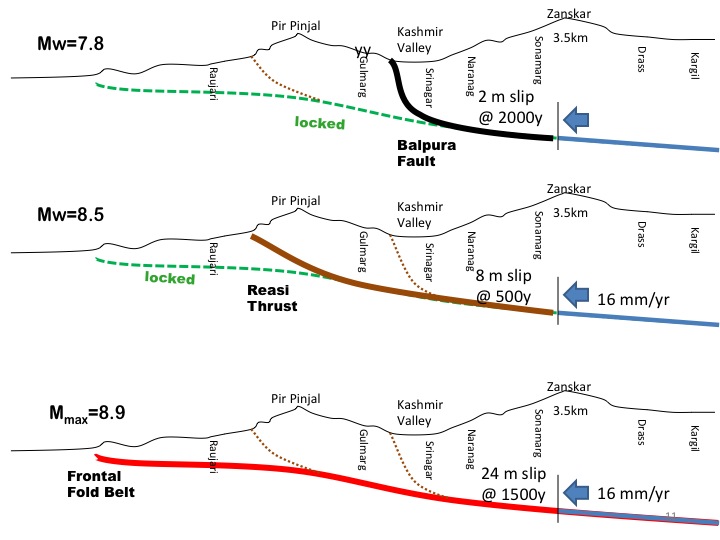Kashmir Seismic Gap figures
(a summary of a talk at the American Geophysical Union in San Francisco Dec. 2011)
No major earthquakes in the Himalaya have occurred between the 2005 Muzafferabad Mw=7.6 earthquake and the 1905 Mw=7.8 Kangra earthquake in the past 450 years. A severe earthquake is known to have occurred in 1555 that damaged structures in the Kashmir valley, but it is not known whether this earthquake ruptured the entire 300 km region between these two earthquakes.
Geodetic convergence between Ladakh and the Pir Pinjal range front measured by the University of Srinagar occurs at 10 mm/yr, and hence we may conclude that approximately 4.5 m of potential slip exists in most of the region of Indian Kashmir. Should this 200x300 sq km region rupture in a single earthquake with 4.5 m of slip it would do so now in a Mw=8.6 earthquake. The 200 km breadth of the velocity field is unusual, and can be interpreted as the response of the Zanskar range to a distributed contraction loaded by the 16 mm/yr convergence measured elsewhere in the western Himalaya. Such a consideration raises the slip potential to 7 m, and Mmax, the maximum credible earthquake, to Mw=8.7.
If, however, the 1555 earthquake did not rupture the entire 200x300 sq km region in an earthquake of such severity (cities such as Peshawar and Lahore would have been shaken by a Mw>8 earthquake but do not report an earthquake at this time) one must conclude that the slip potential in much of the region exceeds 4.5 m. A contiguous great earthquake in 1505 ruptured the Himalaya from near Kangra to near Kathmandu, a distance of ~600 km, with slip of 8-20 m, an event that is presumably associated with a renewal time of more than 1000 years. If we assume a similar recurrence interval for the Kashmir Gap we would conclude that the slip potential in the region may be in the range 9-14m, which would be associated with an earthquake as large as Mw=8.9.

The figure above illustrates possible modes of maximum slip from an inferred locking line beneath the Zanskar range to known surface faults to the SE. Mmax for each assumes similar rupture lengths (300 km) but different recurrence intervals as indicated.
Alternative scenarios
The above estimates for Mmax range fall in the range 8.6<Mw<8.9, but there are good reasons to entertain alternative failure modes in which the region may release the stress associated with India's convergence with Asia. Firstly we know of no great earthquakes in the western Himalaya in the historical record, and possibly the two most recent M>7 earthquakes should be used as a template for the magnitude of future shaking. The problem with this interpretation is that we would need many more M>7 earthquakes than have been observed. The absence of Mw>7 earthquakes in the historical record, however, may be an artifact of poor reporting, or clustering.
A second explanation is that the region is partly-coupled, meaning that parts of the convergent interface may slip by a process known as creep i.e. the rupture zone slides continuously to release the observed convergence signal, and part of the region may never experience earthquakes. If creep is occurring it does so uneventfully because continuous GPS measurements show no evidence for non-linear velocities in the region. This observation neither confirms nor denies the presence of creep, a process that it ubiquitous in the Potwar plateau of Pakistan as a result of thick layers of salt, which may in fact continue beneath the Kashmir region.
Hence alterative scenarios to avoid the potential rupture of the entire region do indeed exist. Further research is essential to clarify the modes of slip of the western Himalaya.
Why discuss Mmax for Kashmir?
Seismologists have failed to inform the public of worst-case earthquake disasters several times in the past decade, despite knowing of their possible consequences. Scientists are reluctant to talk of the largest possible earthquake, because such earthquakes are rare, and therefore unlikely. Our favored method to discuss these unlikely events is to talk among ourselves at academic meetings.
I give three examples to illustrate my own experience with poor communications. An article discussing the 1819 Bhuj earthquake was published a year or so before the devastating 2001 Bhuj earthquake in the same region. Six months before the 2004 Indian Ocean tsunami I gave an invited talk in Bangalore, based on a study of the 1881 Andaman earthquake, which indicated that the east coast of India could expect tsunamis from great earthquakes in the Andaman islands. In this article I assumed Mmax would be Mw=7.9, similar to historical maxima, but showed theoretical tsunami run-up at Chennai from Mw>8 earthquakes. The following year, 5 months before the 2005 Kashmir earthquake, my students and I published an updated forecast of slip potential for the Himalaya that identified the Kashmir region as overdue for a damaging earthquake, but again this information was delivered to an academic audience.
It is important for engineers to know that large earthquakes can occur, much larger than those that have occurred in the past century. There is no reason to fear these large earthquakes if engineers are provided with our best estimates of the duration and amplitudes of anticipated shaking.
To ignore the possible occurrence of large earthquakes, or to remain silent with the knowledge that they could occur, is surely wrong. Scientists have a duty to inform the public of their findings. To silence the scientific community's discussion of large future earthquakes will not prevent their occurrence. Restrictions on the activities of scientists who are engaged in this important research is just as surely counter-productive.